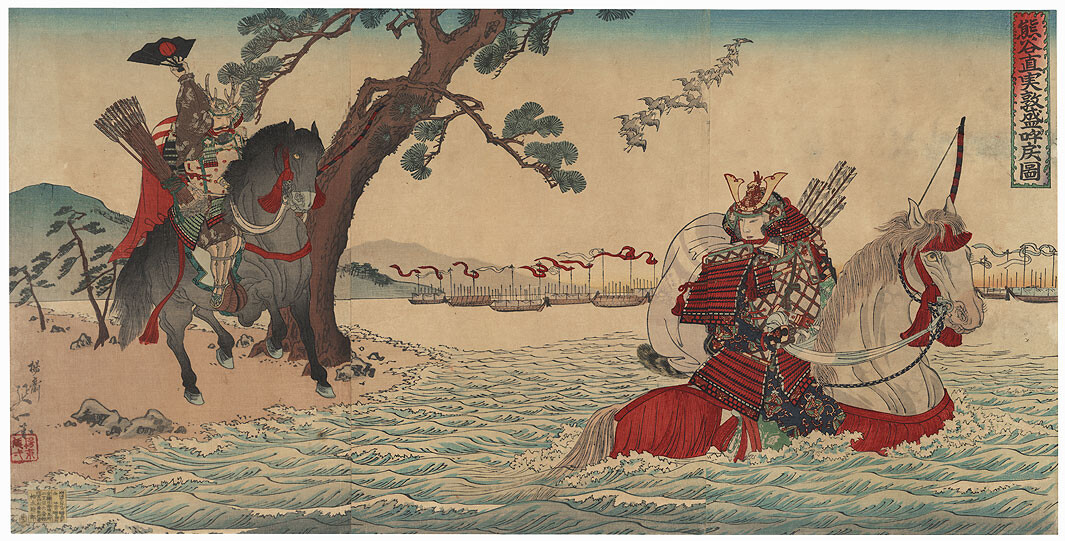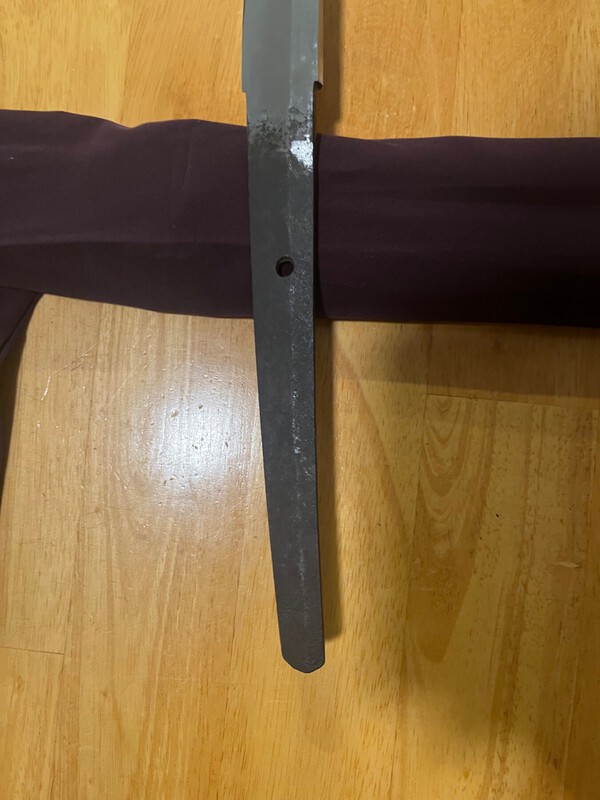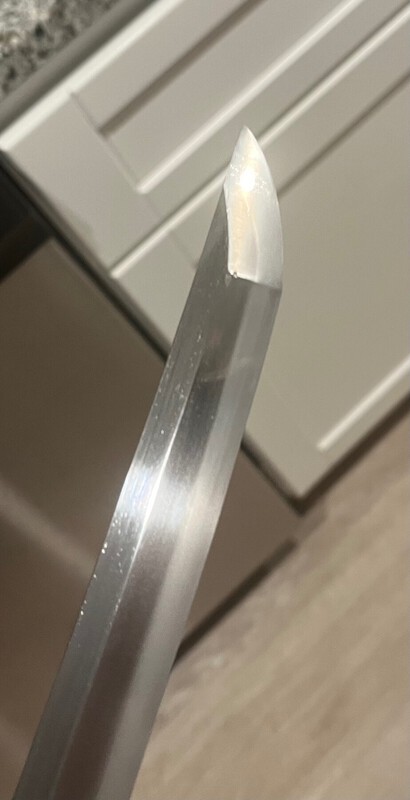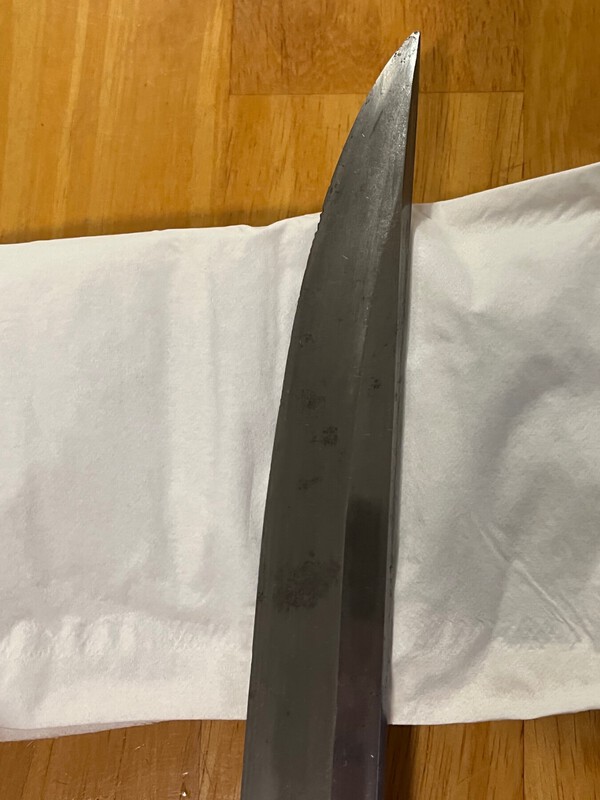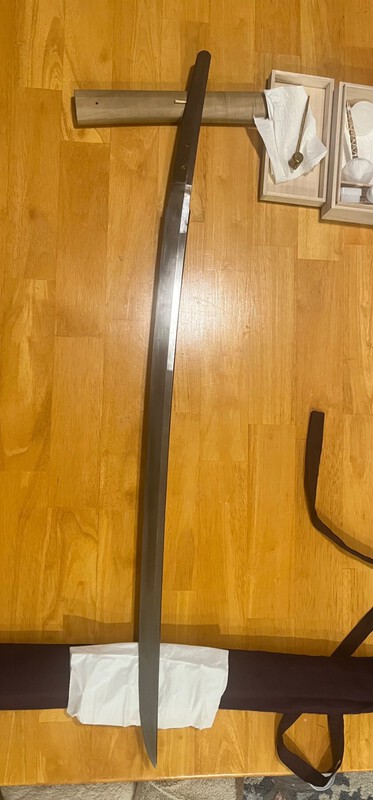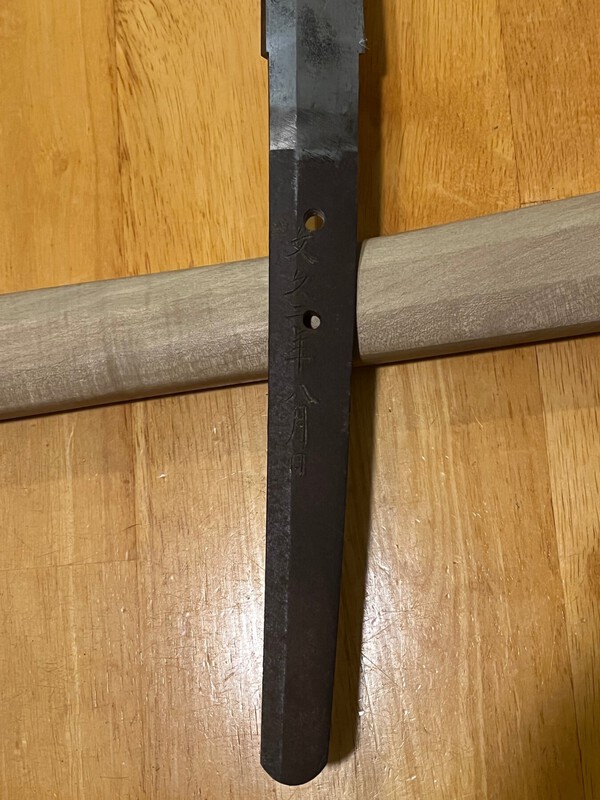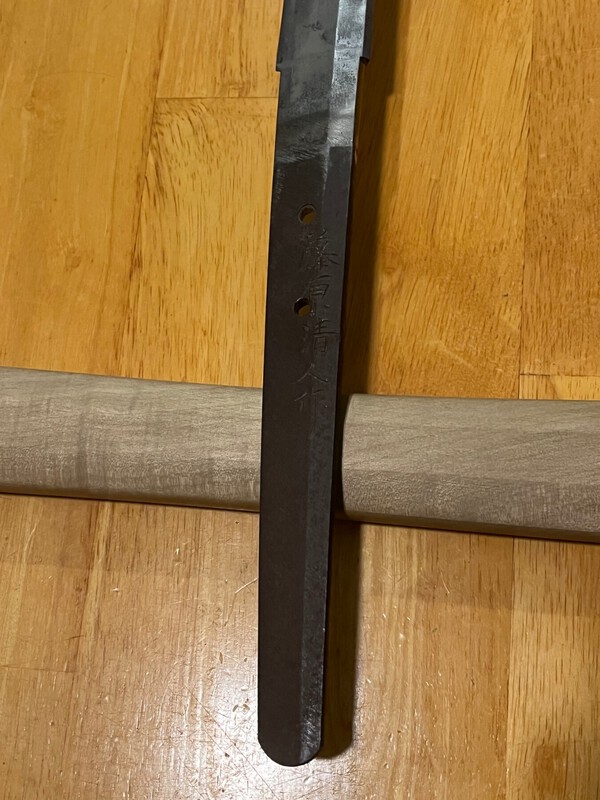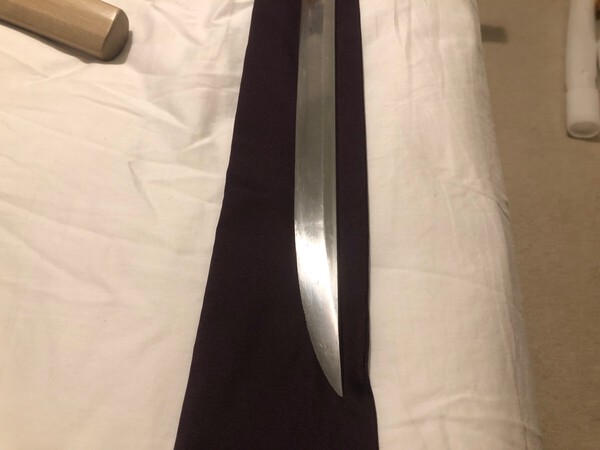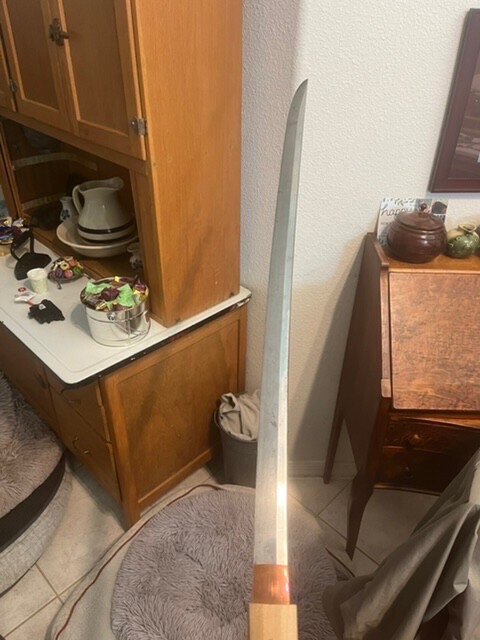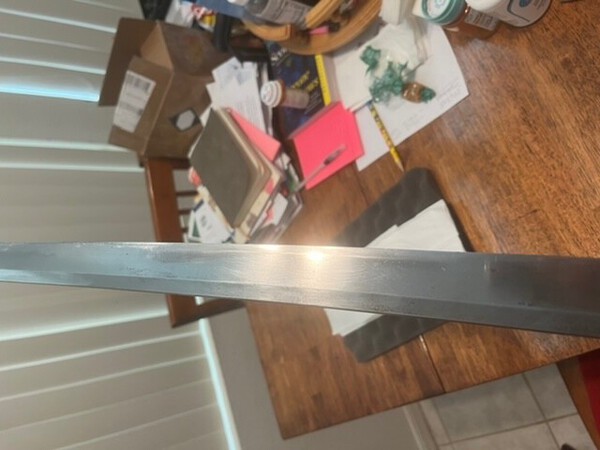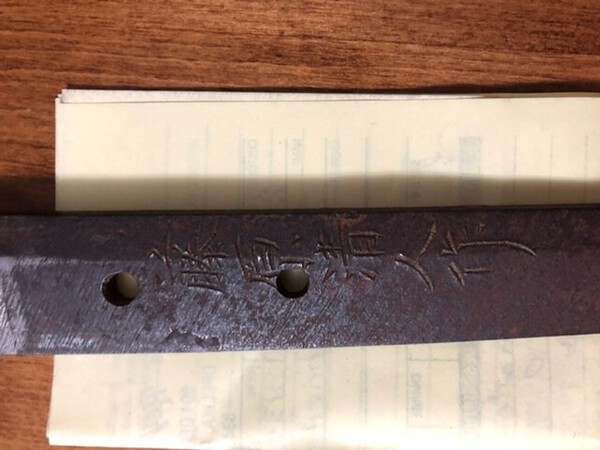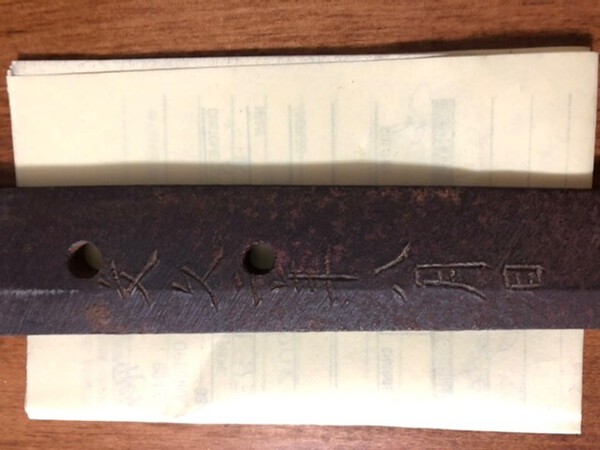-
Posts
25 -
Joined
-
Last visited
Content Type
Profiles
Forums
Events
Store
Downloads
Gallery
Everything posted by Big Jimp
-
Recently at the advice of a friend with shared interest in the preservation of nihonto, I’ve tried and now implemented the use of 99% isopropyl alcohol in my sword care regimen. I’ve used it, rather than uchiko or anything so abrasive, to remove old oil at the start of a cleaning or before studying my blades. My test run was on a showato I posses, and with great result I have since implemented it for use with my nihonto. A partially saturated, folded tissue paper wiped gently across a sword does a fantastic and quick job of removing old oil and evaporating. A single follow-up wipe with dry tissue paper or a microfiber cloth ensures dryness and gets up any remaining bits. The blade is left perfectly cleaned, an unharmed. Everything in moderation, of course. Attached is a photo of my gendai Hizen-tō after such treatment. V/R, Jim
- 25 replies
-
- 4
-

-
Pending Sale to 2devnul
-

Hizen (no) Kuni Masatsugu Shikomizue
Big Jimp replied to Big Jimp's topic in General Nihonto Related Discussion
Thank you very much for this document! I knew that Masatsugu had learned from his father and knew a bit about him, but not that he can be considered an 8th generation Hizen smith. The wealth of information NMB continues to provide is incredible. -

Hizen (no) Kuni Masatsugu Shikomizue
Big Jimp replied to Big Jimp's topic in General Nihonto Related Discussion
Hi Bruce, I was talking with my Sensei the other day and he and I agreed, the little things are big. Good filing on the nakago is one of those little things that really brings a sword to the next level for both of us! And I quite appreciate the little shows of hard work, like the rain pattern on the habaki. ,Jim -
-
-
-
-
-
Considering parting ways with my showato. It is immaculately well polished and has an impressively deep sori (~1.7cm) for its relatively short 64.4cm nagasa. The gunome midare hamon is prominent and has many ashi. The nakago is unmarked and the sword is in shirasaya with a copper habaki. I am considering parting with it simply to clear space in my collection and humbly offer this as an inexpensive entry point to the study and collection of Japanese swords. Though showato are not considered nihonto proper, they are Japanese swords in the literal sense and, I feel, an excellent “jumping off point” to begin one’s sword journey. The sword was purchased from Aoi Art and will ship in its sword bag with an Aoi Art estimation paper and a whole oshigata. Asking 1200 USD shipped in the US, price is negotiable. Including the oshigata and full scan image here, with photos by me to come below.
-

Hizen (no) Kuni Masatsugu Shikomizue
Big Jimp replied to Big Jimp's topic in General Nihonto Related Discussion
-

Hizen (no) Kuni Masatsugu Shikomizue
Big Jimp replied to Big Jimp's topic in General Nihonto Related Discussion
-

Hizen (no) Kuni Masatsugu Shikomizue
Big Jimp replied to Big Jimp's topic in General Nihonto Related Discussion
-

Hizen (no) Kuni Masatsugu Shikomizue
Big Jimp replied to Big Jimp's topic in General Nihonto Related Discussion
-
Just out of export jail and transferred safely to my care, a katana signed by Hizen Kuni Masatsugu, real name Taguchi Kiichi. He was an accepted army swordsmith and was rated a “one million yen smith” at Toko Taikan. NBTHK Hozon papers issued 2021. Based on mei location, overall length and the period it was produced, I believe this sword to be a former gunto. It is around 64cm nagasa with 1.5cm sori. Hamon is a well done, regularly thick suguha and jigane is well packed. It is well polished. What really grabbed my eye though is the koshirae, a meticulously made false hiking stick. Shikomizue were often made with wakizashi, yari, sharpened farming implements or chains as the concealed weapon and were mostly made when it was necessary to conceal one’s weapon. It’s interesting to see a gendaito with such koshirae. I wonder if it was made to scratch a particular itch in the previous owner’s collection, or perhaps for some other reason.
-

Aggressive Shin-Shinto O-Katana
Big Jimp replied to Big Jimp's topic in General Nihonto Related Discussion
Hi all, I’m inclined to agree that the blade has been shortened and I too feel that the boshi/kissaki geometry seems perilous. I think though, that shortening has occurred both at the kissaki and the hamachi. I’ll have to take a photo under better lighting conditions tomorrow but here is a closeup of the kissaki that I snapped yesterday evening. There is a faint hamon present at the kissaki but it appears somewhat thinned out. Though mei legitimacy would be nice, I’m certainly no treasure hunter and am more concerned with a polish of the blade for preservation and study. I will add, that in-person, the blade appears rather wide and thick, delightfully so to the knowledgeable eyes that I’ve shown it to. Thanks, Jim -

Aggressive Shin-Shinto O-Katana
Big Jimp replied to Big Jimp's topic in General Nihonto Related Discussion
I do not have photos of the gunto mounts on hand. Though, it was a rusty metal saya in generally poor condition and the bare wood of the tsuka with gunto fuchikashira, with around 1/2” of ito at the bottom holding the kashira on, tied in makidome. -

Aggressive Shin-Shinto O-Katana
Big Jimp replied to Big Jimp's topic in General Nihonto Related Discussion
Additional information that I forgot to add in the initial post: the blade, as expected, is thickest at the shinogi, slightly more than 1/4 inch at the hamachi, gradually narrowing out and then coming back to around to an almost bulbous feeling 1/4” at the kissaki, quite well balanced. From the yokote, the kissaki is a hair shy of 3” -

Aggressive Shin-Shinto O-Katana
Big Jimp replied to Big Jimp's topic in General Nihonto Related Discussion
-

Aggressive Shin-Shinto O-Katana
Big Jimp replied to Big Jimp's topic in General Nihonto Related Discussion
-

Aggressive Shin-Shinto O-Katana
Big Jimp replied to Big Jimp's topic in General Nihonto Related Discussion
-
Posting this somewhat in reference to an earlier post where I had meant to add additional context and images, but a vacation lead to me losing track of time. Here is my O-katana. It’s an aggressive shinshinto piece, signed Fujiwara Kiyondo and dated 8th month Bunkyū 2. The sword is not papered and the mei is not proven, this blade was discovered in poor condition gunto koshirae at an estate sale. It measures 38.25 inches overall with a 29.2” nagasa. Width of 1.4” at hamachi and 0.88” at yokote, though the yokote is obscured. I believe, based on the placement of the mekugi-ana and other clear indicators that the nakago is not ubu (though I am an amateur). There is around 2cm of ububa on the blade. What little of the hamon is visible is quite pleasing to the eye and I am queued with a few togishi. I am more interested than anything in polish for study and preservation of the sword, which seems to have lived a somewhat difficult life.
-
Hi all, Thanks for your responses, I enjoyed reading over them. I am not concerned with making a profit and am mostly concerned with a polish for study and to ensure that the sword is cared for and has “a nice retirement” after a long and treacherous career. I’m fine with repeating steps, especially since there’s no avoiding it now. I’m not 100% sure where the kissaki begins or whether there even is one (I’ve attached another image showing the faint line which I believe to have been the yokote prior to use). When I return from visiting family I will post some proper dimensions. I’ll also try to better capture the hamon, though it is not very prominent in its current state. It does appear to be a somewhat consistent and well executed suguha with beautiful nioi. I want you all to know that I really appreciate your patience with me as a newbie. My collection right now is this sword, which I chanced across, a gendai tantō I purchased after research, and Nakahara’s Facts and Fundamentals of Japanese Swords. As a philosophy guy and a perennial knowledge seeker, I adore that Nihonto collection, preservation and appreciation is 95% learning. Thanks, James
- 13 replies
-
- 1
-

-
- katana
- shin-shinto
-
(and 1 more)
Tagged with:
-
Hello all, for my second post on NMB I’ll post my first sword, with a story and a question. A few years ago at an estate sale I stumbled upon a katana in very messed up gunto koshirae leaning against the wall of a shed. It was basically just the wood of the tsuka, two seppa and the metal saya. My grandmother’s maternal grandfather was a hatamoto, lineage of which she is quite proud, and she taught me various bits of what to look for and to do if I encountered nihonto. The sword is longer than the typical gunto with around a 29” nagasa, the nakago is signed Fujiwara Kiyondo, dated 1863. I left with it for pennies on the dollar, even at out-of-polish nihonto prices and had a shirasaya and habaki made for it immediately. I’ve attached some images below. It has spots of rust throughout, there are many small nicks in the cutting edge and the ububa remains. It has a magnificent o-kissaki, a somewhat shallow sori, and hints of an active suguha hamon are present. I understand that Kiyondo is a somewhat big name (excellent smith, student of Kiyomaro, etc.) and as such, am treating this sword as gimei until otherwise advised. My questions are, in this current condition, is polish feasible or is it too far gone? If polish is possible, (while my inclination is to do so,) would you pay the steep cost for what are basically entirely sentimental reasons? Finally, who are the better togishi in the greater United States area?
- 13 replies
-
- 1
-

-
- katana
- shin-shinto
-
(and 1 more)
Tagged with:
-
Hello all, I’m a new member and this shall be my inaugural post. After some saving and as a university graduation present to myself, I have acquired a tantō signed “保則 (Yasunori)” and attributed to gendai smith Motomura Yasuhiro by Mr. Tsuruta of Aoi Art. The blade is in decent condition and original polish, I had a shirasaya and tsunagi made for it while I awaited the export permit. Currently, I have the koshirae in a sword bag in a wooden drawer of my china cabinet and the tantō in shirasaya in a sword bag, cutting edge facing up, in a watertight box with foam internal structuring. Are these acceptable storage practices? Additionally how frequently should I oil the blade to keep it preserved? I have been removing the old oil with alcohol and applying new oil once to twice a week (once weekly and when I unsheathe it) for the three weeks that I’ve had it, since I live in a very humid environment. Is this acceptable? I have attached images both for storage reference and to show the tantō. Thank you in advance ,James O.

